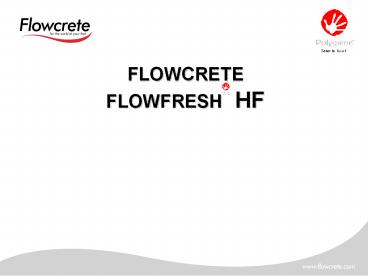FLOWCRETE FLOWFRESH HF - PowerPoint PPT Presentation
1 / 10
Title:
FLOWCRETE FLOWFRESH HF
Description:
FLOWCRETE FLOWFRESH HF Advantages of Polyurethane Concrete High Chemical Resistance, especially inorganic acids High thermal shock resistance, steam cleaning, hot ... – PowerPoint PPT presentation
Number of Views:163
Avg rating:3.0/5.0
Title: FLOWCRETE FLOWFRESH HF
1
FLOWCRETE FLOWFRESH HF
2
Advantages of Polyurethane Concrete
- High Chemical Resistance, especially inorganic
acids - High thermal shock resistance, steam cleaning,
hot spillage, freezers, - Fast installation, 1 layer fast cure
- Positive non-slip, better safety
- Few joints, easy to clean, power wash
- Inclusion of Flowfresh (Polygiene)
anti-microbial, kills bugs
3
Polygiene Applications
- Laminates Paints.
- Domestic Clothing
- Working Surfaces
- Door Handles, Bathroom Accessories
- Medical Preparations Wound Management
- Medical Dressings
- What is Polygiene ?
4
Silver the additive in Polygiene in a
nut-shell
- Silver is a broad-spectrum antimicrobial agent
that controls yeast, mold, and bacteria,
including methicillin-resistant Staphylococcus
aureus (MRSA) and vancomycin-resistant
enterococci (VRE), when it is provided at an
appropriate concentration. It kills microbes on
contact through multiple mechanisms of action,
such as inhibiting cellular respiration,
denaturing nucleic acids, and altering cellular
membrane permeability. Silver has low mammalian
cell toxicity. - Silver does not induce bacterial resistance if
used in adequate concentrations. This is evident
when the literature is reviewed. - Warriner R, Burrrel R, Infection and the Chronic
Wound A Focus on Silver, Advanced Skin Wound
Care, 2005
5
Why Polygiene silver solution
1. Independently tested and verified
Polygiene offers a built-in antimicrobial
protection for the anticipated life time of the
device. Textile show resistance to over 60 wash
cycles on furnishing fabrics. 2. Skin friendly
Many powerful antiseptics irritate the
skin. Silver allergenic potential is low, with
no recorded cases for Polygiene 3. Environment
Silver and silver salts are naturally
occurring, often found in minerals. 4.
Resistance Most germs are able to develop
resistance against antimicrobial agents.
With silver salts, micro organisms show no or
very low tendency to develop resistance according
to the literature.
6
Polygiene validation and microbiological results
Antimicrobial tests and consultancy performed in
Europe Medical Institute for Microbiology,
University of Milan Italy Virology Institute,
University of Catania Italy SIK Institute,
Gothenburg Sweden Lawlabs, Birmingham UK IMSL,
Berkshire UK Test methods used Hard surfaces
JIS Z 2801 (Japanese Industry Standard) Textile
AATCC 100 Antiviral tests performed in
China Institute of Microbiology and
Epidemiology, Military Academy of Medical
Science, Beijing, China
7
Validation independently tested and proven
result
- Material
- All types of plastic
- Laminate
- Paint
- Textile
- Paper
- Porcelain
- Bacteria example
- E-coli
- Staphylococcus aureus
- MRSA (methicillin resistant Staphylococcus
aureus) - Proteus vulgaris
- Pseudomonas aeruginosa
- Salmonella typhi
- Streptococcus pyogenes
- Enterococcus faecalis
Materials with Polygiene prove a bacterial
reduction of 99.9
8
The Novelty
- Decayed organisms killed by Flowfresh release
digested Flowfresh for further protection. - Further Flowfresh is released as the floor
surface is trafficked and worn due to the
homogeneous dispersion of product throughout the
matrix. - So the anti-microbial protection effectively
lasts for the lifespan of the floor
9
Polygiene silver resistant bacteria
- However, it is important to note that bacteria
have been exposed to sub-inhibitory levels of Ag
for over four billion years and no widespread
resistance has been evident to date, whereas
widespread antibiotic resistance has developed
within the last 60 years. - Whilst a number of laboratory-based studies have
indicated a possible association between
bacterial resistance to biocides and
cross-resistance to antibiotics, solid evidence
is lacking. - This study refutes widely, yet unsupported,
hypotheses that use of antibacterial products
facilitates the development of antibiotic
resistance in bacteria. - 1, 2. Percival , et al, Bacterial resistance to
silver in wound care. Journal of Hospital
Infection 2005 - 3. Cole EC, et al. , Investigation of antibiotic
and antibacterial agent cross-resistance in
target bacteria from homes of antibacterial
product users and nonusers. J Appl Microbiol 2003
www.polygiene.com
10
Polygiene how it works
Inhibits the growth of microbes
3.
2.
1.
- The silver is homogenously distributed throughout
the material - Silver migrates to the surface
- Silver ions kills the bacteria on the surface by
penetrating the cell membrane
11
How does Polygiene inhibit the growth of
bacteria?
3 step action to eliminate bacteria effectively
and safely
3
1
2
12
A final thought
- A Study carried out in 17 countries showed that
7 of hospital patients were infected with
bacteria unconnected with the illness for which
they were being treated - A four year study at St Thomas Hospital in London
reveals that cleaning procedures designed to wipe
out the MRSA bug, only reduced contamination
levels as little as 10. - 40 of the pens in doctors breast pockets
carried pathogenic bacteria. - In the average office, the phone is the object
with the highest concentration of germs - 4000
per cm2
13
FOR THE WORLD AT YOUR FEET.

